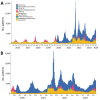Electronic Health Record-Based Algorithm for Monitoring Respiratory Virus-Like Illness
- PMID: 38781684
- PMCID: PMC11138993
- DOI: 10.3201/eid3006.230473
Electronic Health Record-Based Algorithm for Monitoring Respiratory Virus-Like Illness
Abstract
Viral respiratory illness surveillance has traditionally focused on single pathogens (e.g., influenza) and required fever to identify influenza-like illness (ILI). We developed an automated system applying both laboratory test and syndrome criteria to electronic health records from 3 practice groups in Massachusetts, USA, to monitor trends in respiratory viral-like illness (RAVIOLI) across multiple pathogens. We identified RAVIOLI syndrome using diagnosis codes associated with respiratory viral testing or positive respiratory viral assays or fever. After retrospectively applying RAVIOLI criteria to electronic health records, we observed annual winter peaks during 2015-2019, predominantly caused by influenza, followed by cyclic peaks corresponding to SARS-CoV-2 surges during 2020-2024, spikes in RSV in mid-2021 and late 2022, and recrudescent influenza in late 2022 and 2023. RAVIOLI rates were higher and fluctuations more pronounced compared with traditional ILI surveillance. RAVIOLI broadens the scope, granularity, sensitivity, and specificity of respiratory viral illness surveillance compared with traditional ILI surveillance.
Keywords: Massachusetts; RAVIOLI; United States; algorithms; disease surveillance; electronic health records; influenza-like illness; respiratory infections; respiratory virus–like illness; viruses.
Figures



Similar articles
-
Respiratory virus disease and outcomes at a large academic medical center in the United States: a retrospective observational study of the early 2023/2024 respiratory viral season.Microbiol Spectr. 2024 Oct 3;12(10):e0111624. doi: 10.1128/spectrum.01116-24. Epub 2024 Aug 20. Microbiol Spectr. 2024. PMID: 39162510 Free PMC article.
-
When the COVID-19 Pandemic Surges during Influenza Season: Lessons Learnt from the Sentinel Laboratory-Based Surveillance of Influenza-Like Illness in Lombardy during the 2019-2020 Season.Viruses. 2021 Apr 16;13(4):695. doi: 10.3390/v13040695. Viruses. 2021. PMID: 33923819 Free PMC article.
-
Clinical symptoms cannot predict influenza infection during the 2013 influenza season in Bavaria, Germany.Epidemiol Infect. 2016 Apr;144(5):1045-51. doi: 10.1017/S0950268815002228. Epub 2015 Sep 21. Epidemiol Infect. 2016. PMID: 26388141
-
Are we missing respiratory viral infections in infants and children? Comparison of a hospital-based quality management system with standard of care.Clin Microbiol Infect. 2019 Mar;25(3):380.e9-380.e16. doi: 10.1016/j.cmi.2018.05.023. Epub 2018 Jun 12. Clin Microbiol Infect. 2019. PMID: 29906596
-
Physical interventions to interrupt or reduce the spread of respiratory viruses.Cochrane Database Syst Rev. 2020 Nov 20;11(11):CD006207. doi: 10.1002/14651858.CD006207.pub5. Cochrane Database Syst Rev. 2020. Update in: Cochrane Database Syst Rev. 2023 Jan 30;1:CD006207. doi: 10.1002/14651858.CD006207.pub6. PMID: 33215698 Free PMC article. Updated.
Cited by
-
Computable phenotypes to identify respiratory viral infections in the All of Us research program.Sci Rep. 2025 May 28;15(1):18680. doi: 10.1038/s41598-025-02183-9. Sci Rep. 2025. PMID: 40437102 Free PMC article.
-
Computable Phenotypes for Respiratory Viral Infections in the All of Us Research Program.medRxiv [Preprint]. 2025 Jan 18:2025.01.17.25320744. doi: 10.1101/2025.01.17.25320744. medRxiv. 2025. Update in: Sci Rep. 2025 May 28;15(1):18680. doi: 10.1038/s41598-025-02183-9. PMID: 39867363 Free PMC article. Updated. Preprint.
References
-
- Troeger CE, Blacker BF, Khalil IA, Zimsen SRM, Albertson SB, Abate D, et al. ; GBD 2017 Influenza Collaborators. Mortality, morbidity, and hospitalisations due to influenza lower respiratory tract infections, 2017: an analysis for the Global Burden of Disease Study 2017. Lancet Respir Med. 2019;7:69–89. 10.1016/S2213-2600(18)30496-X - DOI - PMC - PubMed
-
- Centers for Disease Control and Prevention. Overview of the National Syndromic Surveillance Program [cited 2022 Aug 9]. https://www.cdc.gov/nssp/documents/NSSP-overview.pdf
Publication types
MeSH terms
LinkOut - more resources
Full Text Sources
Miscellaneous

